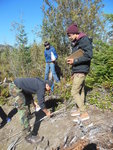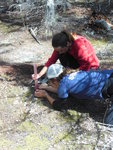


As part of the Center for Agriculture, Science and Environmental Education's (CASEE) efforts to continually educate students through hands-on experience, a group of students and staff took a two-day scientific excursion up Mount St. Helens Sept. 19-20.
The purpose of the hike was to camp, socialize with those sharing a common interest and, most importantly, apply their education to the physical world through real world testing and research.
At 11104 N.E. 149th St., Brush Prairie, sits the epicenter of adolescent scientific research in the Clark County area. CASEE falls under the umbrella of CTE (career and technical education) programs and has a full-time staff who pride themselves on hands-on learning.
The school is described as “a lab in the middle of the district” by CTE Secretary Cindy Arnold. More than 80 acres of land is at the disposal of the CASEE teachers.
Students who are interested in attending CASEE must apply in eighth grade. The CASEE staff will then look at the recommendations students have received from their teachers. It’s important to the staff to know that the students are passionate and fully invested, because they will be doing real testing, in a real environment, with real scientists.
According to Arnold, there is usually no doubt about whether or not the kids who attend CASEE are dedicated young scientists though.
“I would say that probably 90 to 95 percent of all the students who go to CASEE end up majoring in a scientific field,” she said.
The group that annually scales Mount St. Helens is CASEE teacher Irene Catlin’s 10th grade class.
Devin Eastman-Pittam, who attends Battle Ground High School along with CASEE, explained that one primary thing that the young group of scientists were tasked with was identifying native and naturally regenerating species on the mountain.
For the field studies, the students split into four different groups, each with their own instructor, each group doing two different field studies.
Deidre Cepican, a part-time Battle Ground High School student as well, said that the group collected a lot of data from the mountain and also collected soil samples, which they delivered to the staff at Mount St. Helens for testing.
The students will be taking their data collections to present at Washington State University Vancouver later this year as a part of Watershed Congress, an event where local students present their findings to the science community.
The students praised CASEE for the hands-on work it implements into education, and are grateful that they aren’t trapped behind a desk all day. Instead of holding a pencil or a computer mouse, they get to hold elements of the physical world that they are learning about.
As to why all schools aren’t using similar teaching approaches that have proven successful for both them and the school, some of the students feel that money, or lack thereof, is a big issue. A lot of schools, they said, simply don’t have enough land and resources to allow for the kind of outdoor schooling CASEE provides. Furthermore, the students were skeptical as to whether or not a majority of students would want to do it.
“A lot of people just don’t go outside a lot anymore,” said CASEE and Prairie High School student Justine Ingemanson.
Yet for them, the outdoors is where a passion for science was developed at a young age.
Ingemanson said when she was four her family moved to a more rural area where their house was surrounded by trees. Along with her brother — who attended CASEE before her — she would run around outside, trying to find snakes and trying to identify plants.
“My brother and I are pretty nerdy. We like to test each other on plant names when we’re outside,” she said.
One student pointed to his exposure to geology as early as four years old. His mother, as they walked together, would point out different rocks and minerals and name them for him. Soon, he was naming them right along with her.
Another mentioned that her inspiration behind possibly becoming an astrophysicist is because her dad is a “total nerd.”
They would watch Star Trek together; which would segued into them watching “tons” of documentaries together as well.
Visit www.casee.battlegroundps.org to learn more.